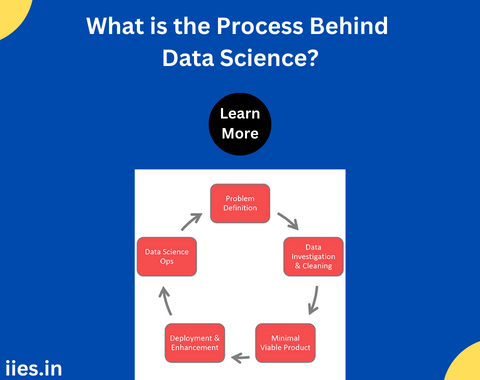
In the digital age, where information is generated at an unprecedented rate, the field of data science has emerged as a powerful tool for extracting meaningful insights from vast datasets.
From predicting customer behavior to optimizing business processes, data science plays a pivotal role in shaping the way organizations operate. This article aims to provide a comprehensive overview of how data science works, delving into its key concepts, methodologies, and applications.
Data science is an interdisciplinary field that encompasses a range of techniques, processes, algorithms, and systems to extract knowledge and insights from structured and unstructured data.
Data science is an interdisciplinary field that encompasses a range of techniques, processes, algorithms, and systems to extract knowledge and insights from structured and unstructured data.
The Data Science Lifecycle:
The data science process is often depicted as a lifecycle, comprising several key stages:
a. Problem Definition: The journey begins with clearly defining the problem at hand. Whether it’s optimizing a business process, predicting trends, or improving decision-making, a well-defined problem is crucial for the success of any data science project.
b. Data Collection: Once the problem is identified, the next step involves gathering relevant data. This data may come from various sources, including databases, sensors, social media, and more. Ensuring data quality and relevance is essential for accurate analysis.
c. Data Cleaning and Preprocessing: Raw data is often messy and incomplete. Data scientists engage in cleaning and preprocessing to handle missing values, remove outliers, and transform data into a format suitable for analysis. This step is critical for obtaining reliable and accurate results.
d. Exploratory Data Analysis (EDA): EDA involves exploring and visualizing the data to gain insights and identify patterns. This stage helps data scientists understand the underlying structure of the data and formulate hypotheses for further testing.
e. Feature Engineering: Feature engineering involves selecting, transforming, and creating features (variables) that are relevant to the problem at hand. This step contributes significantly to the performance of machine learning models.
f. Model Development: In this stage, data scientists select and train models based on the characteristics of the data. Machine learning algorithms, such as regression, decision trees, and neural networks, are commonly employed to make predictions or classifications.
g. Model Evaluation: Once a model is trained, it needs to be evaluated to assess its performance. Metrics like accuracy, precision, recall, and F1 score help measure how well the model generalizes to new, unseen data.
h. Model Deployment: Successful models are deployed into production environments, where they can be utilized to make predictions on new data. This stage involves integrating the model into existing systems, ensuring scalability, and monitoring its performance over time.
i. Monitoring and Maintenance: Continuous monitoring is crucial to ensure that the model performs well in real-world scenarios. If the data distribution changes or new patterns emerge, the model may require updates or retraining.
Key Concepts in Data Science:
a. Machine Learning: A subset of artificial intelligence, machine learning involves the development of algorithms that enable systems to learn patterns from data and make predictions or decisions without explicit programming.
b. Predictive Analytics: Predictive analytics uses statistical algorithms and machine learning techniques to forecast future trends based on historical data. It helps organizations make informed decisions and anticipate outcomes.
c. Artificial Intelligence (AI): AI encompasses a broader range of technologies and applications, including machine learning, natural language processing, and computer vision. Data science often leverages AI techniques to enhance decision-making processes.
d. Big Data: With the increasing volume, velocity, and variety of data generated today, big data technologies are essential for processing and analyzing large datasets. Data scientists use tools like Hadoop and Spark to handle big data challenges.
e. Data Visualization: Communicating insights effectively is crucial in data science. Data visualization tools like Tableau and matplotlib enable data scientists to create meaningful visual representations of complex information.
Applications of Data Science:
a. Healthcare: Data science is revolutionizing healthcare by analyzing patient data to improve diagnostics, predict disease outbreaks, and personalize treatment plans.
b. Finance: In the financial sector, data science is employed for fraud detection, risk management, algorithmic trading, and customer relationship management.
c. Marketing: Data-driven marketing strategies leverage customer data to target audiences more effectively, optimize advertising campaigns, and personalize user experiences.
d. E-commerce: Recommendations engines, demand forecasting, and customer segmentation are just a few examples of how data science is transforming the e-commerce landscape.
e. Manufacturing: Data science enhances manufacturing processes through predictive maintenance, quality control, and supply chain optimization, leading to increased efficiency and cost savings.
As we navigate the ever-expanding digital landscape, data science stands as a beacon of innovation, unlocking the potential hidden within vast datasets. From healthcare to finance, its applications are diverse and impactful, shaping the way organizations operate and make decisions. Understanding the data science lifecycle, key concepts, and applications is essential for harnessing the power of data to drive meaningful insights and advancements across various industries. As technology continues to evolve, the role of data science will undoubtedly become even more integral to our data-driven world.
Indian Institute of Embedded Systems – IIES